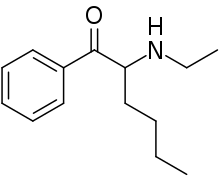N-Ethylhexedrone
N-Ethylhexedrone (also known as α-ethylaminocaprophenone, N-ethylnorhexedrone, hexen, and NEH) is a stimulant of the cathinone class[1][2] that acts as a norepinephrine–dopamine reuptake inhibitor (NDRI) with IC50 values of 0.0978 and 0.0467 μM, respectively.[3] N-Ethylhexedrone was first mentioned in a series of patents by Boehringer Ingelheim in the 1960s[4] which led to the development of the better-known drug methylenedioxypyrovalerone (MDPV).[5] Since the mid-2010s, N-ethylhexedrone has been sold online as a designer drug.[6][7][8] In 2018, N-ethylhexedrone was the second most common drug of the cathinone class to be identified in Drug Enforcement Administration seizures.[9]
 | |
| Legal status | |
|---|---|
| Legal status |
|
| Identifiers | |
IUPAC name
| |
| CAS Number |
|
| PubChem CID | |
| ChemSpider | |
| UNII | |
| Chemical and physical data | |
| Formula | C14H21NO |
| Molar mass | 219.328 g·mol−1 |
| 3D model (JSmol) | |
SMILES
| |
InChI
| |
Legal status
In the United States, N-ethylhexedrone is a Schedule I Controlled Substance.[10] N-Ethylhexedrone is illegal in Japan,[11] and Sweden.[12]
See also
References
- Matsuta, Shuntaro; Katagi, Munehiro; Nishioka, Hiroshi; Kamata, Hiroe; Sasaki, Keiko; Shima, Noriaki; Kamata, Tooru; Miki, Akihiro; Tatsuno, Michiaki; Zaitsu, Kei; Tsuboi, Kento; Tsuchihashi, Hitoshi; Suzuki, Koichi (2014). "Structural characterization of cathinone-type designer drugs by EI mass spectrometry". Japanese Journal of Forensic Science and Technology (in Japanese). 19 (2): 77–89. doi:10.3408/jafst.19.77.
- Kuś, Piotr; Rojkiewicz, Marcin; Kusz, Joachim; Książek, Maria; Sochanik, Aleksander (July 2019). "Spectroscopic characterization and crystal structures of four hydrochloride cathinones: N-ethyl-2-amino-1-phenylhexan-1-one (hexen, NEH), N-methyl-2-amino-1-(4-methylphenyl)-3-methoxypropan-1-one (mexedrone), N-ethyl-2-amino-1-(3,4-methylenedioxyphenyl)pentan-1-one (ephylone) and N-butyl-2-amino-1-(4-chlorophenyl)propan-1-one (4-chlorobutylcathinone)". 37 (2): 456–464. doi:10.1007/s11419-019-00477-y. ISSN 1860-8973. Cite journal requires
|journal=(help) - Eshleman, Amy J.; Nagarajan, Shanthi; Wolfrum, Katherine M.; Reed, John F.; Swanson, Tracy L.; Nilsen, Aaron; Janowsky, Aaron (March 2019). "Structure-activity relationships of bath salt components: substituted cathinones and benzofurans at biogenic amine transporters". Psychopharmacology. 236 (3): 939–952. doi:10.1007/s00213-018-5059-5. ISSN 1432-2072. PMID 30397775.
- Herbert, Koeppe; Karl, Zeile; Gerhard, Ludwig (28 May 1965), Patent DE1545591 - Verfahren zur Herstellung von α-Aminoketonen mit heterocyclischer Aminogruppe (in German)
- Kolanos, Renata; Solis, Ernesto; Sakloth, Farhana; Felice, Louis J. De; Glennon, Richard A. (18 December 2013). ""Deconstruction" of the Abused Synthetic Cathinone Methylenedioxypyrovalerone (MDPV) and an Examination of Effects at the Human Dopamine Transporter". ACS Chemical Neuroscience. 4 (12): 1524–1529. doi:10.1021/cn4001236. PMC 3867964. PMID 24116392.
- "2-(Ethylamino)-1-phenylhexan-1-one". New Synthetic Drugs Database.
- "Analytical Report - N-Ethylhexedrone" (PDF). European Project RESPONSE.
- Liu, Cuimei; Jia, Wei; Li, Tao; Hua, Zhendong; Qian, Zhenhua (2017). "Identification and analytical characterization of nine synthetic cathinone derivatives N‐ethylhexedrone, 4‐Cl‐pentedrone, 4‐Cl‐α‐EAPP, propylone, N‐ethylnorpentylone, 6‐MeO‐bk‐MDMA, α‐PiHP, 4‐Cl‐α‐PHP, and 4‐F‐α‐PHP". Drug Testing and Analysis. 9 (8): 1162–1171. doi:10.1002/dta.2136. PMID 27863142.
- "Emerging Threat Report: Annual 2018" (PDF). Special Testing and Research Laboratory, Drug Enforcement Administration.
- "Schedules of Controlled Substances: Temporary Placement of N-Ethylhexedrone, α-PHP, 4-MEAP, MPHP, PV8, and 4-Chloro-α-PVP in Schedule I". Drug Enforcement Administration.
- "指定薬物一覧" [Designated drug list] (PDF) (in Japanese). Ministry of Health, Labour and Welfare.
- "31 nya ämnen kan klassas som narkotika eller hälsofarlig vara" [31 new substances can be classified as drugs or health hazardous products] (in Swedish). Folkhälsomyndigheten. 21 June 2016.